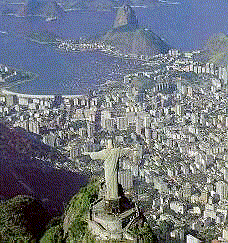

 |

|

|
|
At the beginning of the 16th century, the Portuguese explorers who sailed down Brazil's coast kept track of their discoveries, and the days of the year, by naming the former for the latter. On New Year's Day, 1502, they glided toward a narrow opening in the coastline, guarded by fabulously shaped mountains. Beyond this entrance lay a body of water stretching 20 miles inland. Convinced that they had reached the mouth of a great river, they named the area River of the First of January. The large waterway was not a river; it was an island-studded bay that the Tamoio people had long before named Guanabara - "arm of the sea." Nearly five centuries later, both the native and European names persist. But now, instead of caravels and dugouts, supertankers and yachts glide across the magnificent balloon-shaped harbor of Guanabara Bay. No longer a tropical wilderness teeming with tapirs and jaguars, the bay's western shores now hold a roaring metropolis called Rio de Janeiro - the River of January. The great bay that looked like a river was only one of many illusions that Rio held. Europeans called the smaller bay of Botafago, under Sugarloaf, a "lake"; the Tamoio themselves named Guanabara Bay's eastern edge Niteroi, meaning "hidden waters." For early European voyagers, it was as though, when Rio hove into view, the curtain rose on a stage set with such strange, striking shapes and forms that virtually everything looked like something else. Guarding the entrance to the bay, the naked and lopsided mountain the Portuguese called Pao de Acucar evoked the sugarloaves fashioned on the island of Madeira. They called the highest mountain Corcovado - "the hunchback" - for its humped profile. Today, a statue of Christ the Redeemer crowns the 2,300-foot-high peak. The bay's vastness has been shrinking. With usable land at
a premium, landfill has twice altered Guanabara Bay's contours. In the 1920s
and again in the 1960s, small hills that once had been home to Rio's earliest
settlers were sluiced through pipes to create bayfill. The new land now anchors
an airport, a six-lane highway, parkland and beaches, the city's modern art
museum, and other 20th-century landmarks as Rio looks to its great bay for elbow
room. Source: The Wonders of the World, National Geographic Society |
CAN'T FIND WHAT YOU'RE LOOKING FOR? CLICK HERE!!!